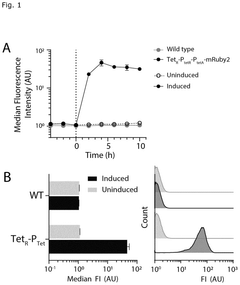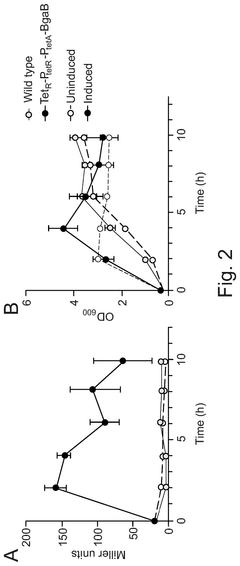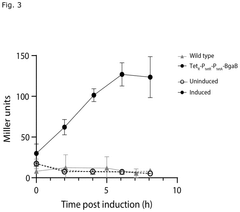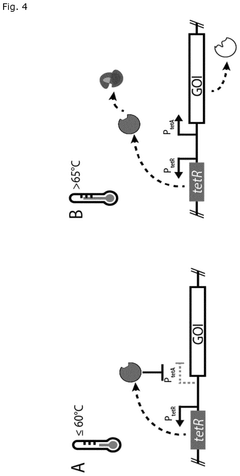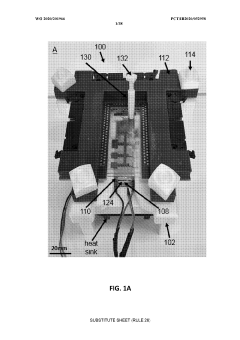Regulatory Implications of Thermal Management in Synthetic Biology
SEP 19, 20259 MIN READ
Generate Your Research Report Instantly with AI Agent
Patsnap Eureka helps you evaluate technical feasibility & market potential.
Synthetic Biology Thermal Regulation Background and Objectives
Synthetic biology has evolved significantly over the past two decades, transitioning from basic genetic circuit design to complex engineered biological systems capable of performing sophisticated functions. Thermal management has emerged as a critical factor in this evolution, as temperature directly impacts enzyme kinetics, protein folding, metabolic rates, and overall system stability. The historical development of synthetic biology has largely focused on genetic manipulation while often overlooking the precise thermal regulation necessary for optimal performance of engineered biological systems.
Temperature sensitivity in biological systems presents both challenges and opportunities for synthetic biology applications. Historically, most synthetic biology platforms were designed to operate within narrow temperature ranges, typically around 37°C for mammalian systems or 30°C for yeast-based systems. This limitation has restricted deployment in diverse environments and applications where temperature fluctuations are common.
Recent technological advances have expanded our understanding of thermosensitive biological components, including temperature-responsive promoters, thermostable enzymes, and heat-shock response elements. These developments have created new possibilities for designing synthetic biological systems with enhanced thermal tolerance or specific temperature-dependent functionalities. The integration of these components into synthetic circuits represents a significant frontier in the field.
The regulatory landscape surrounding thermally-managed synthetic biology systems remains largely underdeveloped. Current regulations primarily address genetic modification aspects while providing limited guidance on thermal management parameters. This regulatory gap presents challenges for technology deployment, particularly in applications where temperature control intersects with safety considerations.
The primary objectives of this technical research are threefold. First, to comprehensively map the current state of thermal management technologies in synthetic biology, identifying key innovations and limitations. Second, to analyze existing regulatory frameworks across major jurisdictions and their applicability to thermally-controlled biological systems. Third, to forecast potential regulatory developments and propose adaptive strategies for industry stakeholders navigating this evolving landscape.
This research aims to bridge the technical and regulatory domains by providing insights into how thermal management considerations in synthetic biology may influence future regulatory approaches. By anticipating regulatory challenges and opportunities, organizations can develop more robust implementation strategies for thermally-optimized synthetic biology applications across healthcare, agriculture, biomanufacturing, and environmental remediation sectors.
Temperature sensitivity in biological systems presents both challenges and opportunities for synthetic biology applications. Historically, most synthetic biology platforms were designed to operate within narrow temperature ranges, typically around 37°C for mammalian systems or 30°C for yeast-based systems. This limitation has restricted deployment in diverse environments and applications where temperature fluctuations are common.
Recent technological advances have expanded our understanding of thermosensitive biological components, including temperature-responsive promoters, thermostable enzymes, and heat-shock response elements. These developments have created new possibilities for designing synthetic biological systems with enhanced thermal tolerance or specific temperature-dependent functionalities. The integration of these components into synthetic circuits represents a significant frontier in the field.
The regulatory landscape surrounding thermally-managed synthetic biology systems remains largely underdeveloped. Current regulations primarily address genetic modification aspects while providing limited guidance on thermal management parameters. This regulatory gap presents challenges for technology deployment, particularly in applications where temperature control intersects with safety considerations.
The primary objectives of this technical research are threefold. First, to comprehensively map the current state of thermal management technologies in synthetic biology, identifying key innovations and limitations. Second, to analyze existing regulatory frameworks across major jurisdictions and their applicability to thermally-controlled biological systems. Third, to forecast potential regulatory developments and propose adaptive strategies for industry stakeholders navigating this evolving landscape.
This research aims to bridge the technical and regulatory domains by providing insights into how thermal management considerations in synthetic biology may influence future regulatory approaches. By anticipating regulatory challenges and opportunities, organizations can develop more robust implementation strategies for thermally-optimized synthetic biology applications across healthcare, agriculture, biomanufacturing, and environmental remediation sectors.
Market Analysis of Thermally Regulated Bioprocesses
The global market for thermally regulated bioprocesses is experiencing significant growth, driven by advancements in synthetic biology and increasing demand for biopharmaceuticals, biofuels, and other bio-based products. Current market valuations indicate that the synthetic biology market reached approximately $9.5 billion in 2021 and is projected to grow at a compound annual growth rate of 24% through 2028, with thermally regulated processes representing a crucial segment of this expansion.
Temperature-controlled bioprocesses are particularly valuable in industrial biotechnology, where precise thermal management directly impacts product yield, quality, and production costs. The pharmaceutical sector currently dominates the application landscape, accounting for roughly 35% of market share, followed by industrial enzymes (28%), biofuels (18%), and agricultural applications (12%).
Regional analysis reveals that North America leads the market with approximately 42% share, benefiting from robust research infrastructure and significant private investment. Europe follows at 30%, with particular strength in industrial enzyme applications and stringent regulatory frameworks that favor precisely controlled bioprocesses. The Asia-Pacific region, growing at the fastest rate of 28% annually, is rapidly developing capacity in this sector, particularly in China, South Korea, and Singapore.
Consumer demand patterns indicate increasing preference for sustainably produced biochemicals and materials, creating market pull for thermally efficient bioprocesses that minimize energy consumption and environmental impact. This trend is reinforced by corporate sustainability commitments and regulatory pressures in major markets.
Investment patterns show substantial capital flowing into companies developing advanced thermal regulation technologies for bioprocesses, with venture capital funding in this specific segment increasing by 45% in the past three years. Strategic partnerships between technology providers and bioprocess industries have also accelerated, with over 60 major collaborations announced since 2020.
Market barriers include high initial capital requirements for sophisticated thermal management systems, regulatory uncertainties regarding novel bioprocesses, and technical challenges in scaling temperature-controlled systems from laboratory to industrial scale. These factors have created a competitive landscape where established bioprocess equipment manufacturers are being challenged by innovative startups offering more precise, efficient thermal regulation solutions.
Forecasts suggest that the market for thermally regulated bioprocesses will continue to expand as synthetic biology applications proliferate across industries, with particularly strong growth anticipated in personalized medicine, sustainable materials, and next-generation biofuels sectors where thermal regulation directly impacts product efficacy and production economics.
Temperature-controlled bioprocesses are particularly valuable in industrial biotechnology, where precise thermal management directly impacts product yield, quality, and production costs. The pharmaceutical sector currently dominates the application landscape, accounting for roughly 35% of market share, followed by industrial enzymes (28%), biofuels (18%), and agricultural applications (12%).
Regional analysis reveals that North America leads the market with approximately 42% share, benefiting from robust research infrastructure and significant private investment. Europe follows at 30%, with particular strength in industrial enzyme applications and stringent regulatory frameworks that favor precisely controlled bioprocesses. The Asia-Pacific region, growing at the fastest rate of 28% annually, is rapidly developing capacity in this sector, particularly in China, South Korea, and Singapore.
Consumer demand patterns indicate increasing preference for sustainably produced biochemicals and materials, creating market pull for thermally efficient bioprocesses that minimize energy consumption and environmental impact. This trend is reinforced by corporate sustainability commitments and regulatory pressures in major markets.
Investment patterns show substantial capital flowing into companies developing advanced thermal regulation technologies for bioprocesses, with venture capital funding in this specific segment increasing by 45% in the past three years. Strategic partnerships between technology providers and bioprocess industries have also accelerated, with over 60 major collaborations announced since 2020.
Market barriers include high initial capital requirements for sophisticated thermal management systems, regulatory uncertainties regarding novel bioprocesses, and technical challenges in scaling temperature-controlled systems from laboratory to industrial scale. These factors have created a competitive landscape where established bioprocess equipment manufacturers are being challenged by innovative startups offering more precise, efficient thermal regulation solutions.
Forecasts suggest that the market for thermally regulated bioprocesses will continue to expand as synthetic biology applications proliferate across industries, with particularly strong growth anticipated in personalized medicine, sustainable materials, and next-generation biofuels sectors where thermal regulation directly impacts product efficacy and production economics.
Current Challenges in Synthetic Biology Thermal Management
Synthetic biology thermal management faces significant regulatory challenges due to the complex interplay between biological systems and thermal conditions. Current regulatory frameworks across different jurisdictions exhibit considerable variation in how they address thermal aspects of synthetic biology applications. This inconsistency creates compliance difficulties for researchers and companies operating internationally, as they must navigate disparate requirements for thermal safety protocols and documentation.
The absence of standardized thermal management guidelines specifically tailored for synthetic biology represents a critical regulatory gap. While general laboratory safety standards exist, they often fail to address the unique thermal considerations of engineered biological systems, particularly those designed to function at non-standard temperatures or with altered thermal responses. This regulatory vacuum has led to ad hoc approaches that may inadequately address potential risks.
Risk assessment methodologies for thermal management in synthetic biology remain underdeveloped within regulatory contexts. Current frameworks struggle to effectively evaluate the potential consequences of thermal anomalies in engineered organisms, especially regarding containment failures, unintended metabolic responses, or ecological impacts should organisms escape controlled environments. The dynamic nature of living systems compounds this challenge, as thermal responses may evolve or manifest differently under varying environmental conditions.
Regulatory bodies face significant technical knowledge gaps regarding thermal management in synthetic biology. Many regulators lack specialized expertise in this interdisciplinary field, which combines principles from biology, engineering, and thermodynamics. This knowledge deficit impedes the development of informed, science-based regulations that can keep pace with rapid technological advancements while ensuring adequate safeguards.
The international harmonization of thermal management regulations presents another major challenge. Cross-border research collaborations and global supply chains in synthetic biology necessitate coordinated regulatory approaches, yet current international coordination mechanisms remain insufficient. This fragmentation creates inefficiencies and potential safety gaps as thermal management practices vary widely across national boundaries.
Emerging applications in synthetic biology, such as thermally responsive biosensors and temperature-activated gene circuits, are outpacing regulatory frameworks. These novel technologies introduce unprecedented thermal considerations that existing regulations were not designed to address, creating uncertainty for both innovators and regulators about appropriate safety measures and approval pathways.
Data sharing and transparency requirements regarding thermal management protocols also present regulatory challenges. While comprehensive data collection is essential for safety assessment, concerns about intellectual property protection and competitive advantage often limit information sharing, hampering regulatory oversight and the development of evidence-based standards for thermal management in synthetic biology applications.
The absence of standardized thermal management guidelines specifically tailored for synthetic biology represents a critical regulatory gap. While general laboratory safety standards exist, they often fail to address the unique thermal considerations of engineered biological systems, particularly those designed to function at non-standard temperatures or with altered thermal responses. This regulatory vacuum has led to ad hoc approaches that may inadequately address potential risks.
Risk assessment methodologies for thermal management in synthetic biology remain underdeveloped within regulatory contexts. Current frameworks struggle to effectively evaluate the potential consequences of thermal anomalies in engineered organisms, especially regarding containment failures, unintended metabolic responses, or ecological impacts should organisms escape controlled environments. The dynamic nature of living systems compounds this challenge, as thermal responses may evolve or manifest differently under varying environmental conditions.
Regulatory bodies face significant technical knowledge gaps regarding thermal management in synthetic biology. Many regulators lack specialized expertise in this interdisciplinary field, which combines principles from biology, engineering, and thermodynamics. This knowledge deficit impedes the development of informed, science-based regulations that can keep pace with rapid technological advancements while ensuring adequate safeguards.
The international harmonization of thermal management regulations presents another major challenge. Cross-border research collaborations and global supply chains in synthetic biology necessitate coordinated regulatory approaches, yet current international coordination mechanisms remain insufficient. This fragmentation creates inefficiencies and potential safety gaps as thermal management practices vary widely across national boundaries.
Emerging applications in synthetic biology, such as thermally responsive biosensors and temperature-activated gene circuits, are outpacing regulatory frameworks. These novel technologies introduce unprecedented thermal considerations that existing regulations were not designed to address, creating uncertainty for both innovators and regulators about appropriate safety measures and approval pathways.
Data sharing and transparency requirements regarding thermal management protocols also present regulatory challenges. While comprehensive data collection is essential for safety assessment, concerns about intellectual property protection and competitive advantage often limit information sharing, hampering regulatory oversight and the development of evidence-based standards for thermal management in synthetic biology applications.
Established Thermal Management Approaches in Bioprocessing
01 Temperature control systems for synthetic biological processes
Advanced temperature control systems are essential for maintaining optimal conditions in synthetic biology applications. These systems incorporate sensors, controllers, and cooling mechanisms to regulate temperature within precise parameters required for biological processes. Effective thermal management ensures the stability and functionality of engineered biological systems, preventing degradation of sensitive biomolecules and maintaining cellular viability.- Temperature control systems for synthetic biological processes: Advanced thermal management systems designed specifically for synthetic biology applications, including temperature-sensitive enzymatic reactions and genetic circuits. These systems incorporate precise control mechanisms to maintain optimal temperature conditions for biological processes, ensuring stability and reproducibility of synthetic biological systems while complying with regulatory requirements for containment and safety.
- Regulatory frameworks for thermal safety in bioengineered systems: Comprehensive regulatory approaches addressing thermal management in synthetic biology, focusing on safety protocols, risk assessment methodologies, and compliance standards. These frameworks establish guidelines for preventing thermal runaway reactions in engineered biological systems, define containment requirements based on heat generation potential, and outline reporting procedures for thermal incidents in research and industrial applications.
- Heat dissipation technologies for bioreactors and fermentation systems: Innovative heat exchange and dissipation technologies specifically designed for bioreactors and fermentation systems used in synthetic biology applications. These technologies include advanced cooling systems, thermal interface materials, and heat sink designs that efficiently manage metabolic heat generation in high-density cell cultures and engineered microorganisms, ensuring process stability while meeting regulatory requirements for containment.
- Computational models for thermal behavior prediction in synthetic biosystems: Sophisticated computational modeling approaches for predicting thermal behavior in synthetic biological systems, enabling proactive regulatory compliance. These models integrate thermodynamic principles with biological parameters to simulate heat generation patterns in engineered organisms, predict potential thermal risks, and optimize cooling requirements for various synthetic biology applications, supporting evidence-based regulatory decision-making.
- Thermal monitoring and reporting systems for regulatory compliance: Integrated monitoring and reporting systems designed to track thermal parameters in synthetic biology operations for regulatory compliance. These systems incorporate real-time temperature sensors, automated alert mechanisms, and data logging capabilities that document thermal conditions throughout bioprocessing operations, generating compliance reports for regulatory authorities and enabling traceability of thermal management practices in synthetic biology applications.
02 Regulatory frameworks for biosafety in synthetic biology
Regulatory frameworks addressing thermal management in synthetic biology focus on biosafety protocols and containment strategies. These regulations establish standards for temperature monitoring and control in facilities working with engineered biological systems. Compliance requirements include documentation of thermal management protocols, risk assessment procedures, and contingency plans for temperature-related failures to prevent unintended release or proliferation of synthetic organisms.Expand Specific Solutions03 Heat dissipation technologies for bioreactors and bioprocessing equipment
Specialized heat dissipation technologies have been developed for bioreactors and bioprocessing equipment used in synthetic biology applications. These include microfluidic cooling channels, phase-change materials, and advanced heat sink designs that efficiently remove excess heat while maintaining sterile conditions. Such technologies enable precise temperature gradients and prevent localized hotspots that could compromise biological function or trigger undesired regulatory responses in engineered organisms.Expand Specific Solutions04 Computational modeling for thermal regulation in synthetic biological systems
Computational approaches are increasingly used to model and predict thermal behavior in synthetic biological systems. These models integrate thermodynamic principles with biological parameters to simulate heat generation, dissipation, and effects on regulatory networks. Machine learning algorithms analyze thermal data to optimize temperature control strategies and predict system responses to thermal fluctuations, enabling more robust design of synthetic biological circuits and regulatory elements.Expand Specific Solutions05 Integration of thermal sensors with biological regulatory circuits
Innovative approaches combine thermal sensing elements with biological regulatory circuits to create responsive systems that adapt to temperature changes. These integrated systems utilize temperature-sensitive promoters, RNA thermosensors, or engineered proteins that respond to thermal cues by altering gene expression or metabolic pathways. Such integration allows synthetic biological systems to self-regulate in response to thermal conditions, enhancing stability and performance across varying environmental conditions.Expand Specific Solutions
Leading Organizations in Synthetic Biology Thermal Solutions
The regulatory landscape for thermal management in synthetic biology is evolving rapidly as the field matures. Currently, the industry is in its early growth phase, characterized by increasing research activities but still developing commercial applications. Market size is projected to expand significantly as synthetic biology solutions address challenges in healthcare, agriculture, and industrial biotechnology. From a technical maturity perspective, leading academic institutions like MIT, Boston University, and Duke University are driving fundamental research, while companies such as New England Biolabs and Cepheid are developing practical applications. Corporate players like Intel and Koninklijke Philips are exploring thermal management solutions that could address regulatory concerns around biosafety and containment. The regulatory framework remains fragmented globally, requiring companies to navigate complex compliance requirements across different jurisdictions.
Massachusetts Institute of Technology
Technical Solution: MIT has developed a comprehensive thermal regulation platform for synthetic biology applications that integrates microfluidic cooling systems with real-time monitoring capabilities. Their approach utilizes specialized heat-responsive promoters and temperature-sensitive genetic circuits that can automatically adjust metabolic pathways in engineered organisms based on thermal conditions. The system incorporates CRISPR-based thermal switches that activate or deactivate specific gene expressions when temperature thresholds are crossed, ensuring optimal performance while maintaining regulatory compliance. MIT researchers have also pioneered thermal management protocols that address both FDA and EPA regulatory concerns by implementing fail-safe mechanisms that prevent engineered organisms from surviving outside controlled temperature environments, effectively creating a physical containment strategy that complements genetic safeguards.
Strengths: Advanced integration of genetic and physical thermal control systems; strong regulatory compliance focus with built-in safety mechanisms; extensive validation in industrial applications. Weaknesses: Complex implementation requiring specialized expertise; higher implementation costs compared to conventional approaches; potential challenges in scaling to industrial production volumes.
Duke University
Technical Solution: Duke University has developed a thermal regulation framework specifically designed to address regulatory challenges in synthetic biology applications. Their approach centers on a dual-control system that combines genetic thermal switches with external temperature management infrastructure. The system features engineered heat-shock proteins and temperature-responsive RNA thermometers that can modulate gene expression in response to thermal fluctuations. Duke researchers have created regulatory-compliant documentation templates that map thermal control points to specific FDA and EPA requirements, facilitating approval processes. Their platform includes continuous monitoring systems that generate audit trails of thermal conditions throughout the bioprocess lifecycle, addressing key regulatory concerns about process consistency and containment. The university has also pioneered thermal kill-switch mechanisms that render engineered organisms non-viable when exposed to temperatures outside approved ranges, providing an additional layer of biosafety that aligns with emerging regulatory frameworks for synthetic biology applications.
Strengths: Comprehensive regulatory documentation approach integrated with technical solutions; validated kill-switch mechanisms enhance biosafety profile; strong focus on audit trail generation for compliance verification. Weaknesses: System requires significant customization for different organism types; relatively high implementation complexity; ongoing maintenance and calibration requirements.
Key Patents in Biological Temperature Control Systems
Temperature-inducible expression system for thermophilic organisms
PatentPendingUS20250059579A1
Innovation
- Utilization of a Tet repressor (TetR) protein-based expression control system that employs temperature regulation instead of chemical inducers to control gene expression in thermophilic host cells, where the TetR protein binds to a tet operator (tetO) sequence and represses gene expression at lower temperatures, allowing induction at higher temperatures.
Integration of world-to-chip interfaces with digital microfluidics for bacterial transformation and enzymatic assays
PatentWO2020201966A1
Innovation
- Integration of a 3D printed fluidic port for reagent delivery and a thermoelectric cooler (TEC) with closed-loop temperature control using a proportional-integral-derivative (PID) controller, enabling precise temperature control and continuous reagent replenishment.
Regulatory Framework for Engineered Biological Systems
The regulatory landscape for engineered biological systems has evolved significantly in response to the growing complexity of synthetic biology applications, particularly those involving thermal management considerations. Current regulatory frameworks are primarily structured around three key pillars: biosafety, biosecurity, and bioethics, with thermal management increasingly recognized as a critical cross-cutting concern. In the United States, the Coordinated Framework for Regulation of Biotechnology, involving the FDA, EPA, and USDA, provides oversight but lacks specific provisions for thermal management in engineered organisms.
International governance mechanisms, including the Cartagena Protocol on Biosafety and the Biological Weapons Convention, establish baseline standards for transboundary movement and risk assessment of genetically modified organisms. However, these frameworks were developed before the emergence of advanced synthetic biology techniques that incorporate sophisticated thermal regulation mechanisms, creating regulatory gaps that require attention.
Risk assessment methodologies for engineered biological systems traditionally focus on genetic modifications and potential environmental impacts, with thermal properties often receiving insufficient consideration. This oversight is particularly problematic as thermally-regulated biological systems may exhibit behavior patterns that differ significantly from conventional GMOs, especially when deployed in varying environmental conditions.
Regulatory divergence across jurisdictions presents significant challenges for developers of thermally-managed biological systems. The European Union employs a precautionary approach through Directive 2001/18/EC, requiring comprehensive environmental risk assessments that increasingly consider thermal properties. In contrast, countries like Japan and Singapore have adopted more innovation-friendly regulatory stances, potentially accelerating development but raising harmonization concerns.
Recent regulatory developments indicate a trend toward more adaptive governance models that can accommodate the rapid pace of innovation in synthetic biology. The concept of "anticipatory governance" has gained traction, emphasizing proactive engagement with emerging technologies rather than reactive regulation. This approach incorporates stakeholder participation, scientific evidence, and ethical considerations into regulatory decision-making processes.
Standardization efforts for thermal management in engineered biological systems remain in nascent stages. Organizations such as the International Organization for Standardization (ISO) and the International Gene Synthesis Consortium (IGSC) have begun developing technical standards and best practices, though comprehensive frameworks specifically addressing thermal regulation in synthetic biology applications are still emerging.
International governance mechanisms, including the Cartagena Protocol on Biosafety and the Biological Weapons Convention, establish baseline standards for transboundary movement and risk assessment of genetically modified organisms. However, these frameworks were developed before the emergence of advanced synthetic biology techniques that incorporate sophisticated thermal regulation mechanisms, creating regulatory gaps that require attention.
Risk assessment methodologies for engineered biological systems traditionally focus on genetic modifications and potential environmental impacts, with thermal properties often receiving insufficient consideration. This oversight is particularly problematic as thermally-regulated biological systems may exhibit behavior patterns that differ significantly from conventional GMOs, especially when deployed in varying environmental conditions.
Regulatory divergence across jurisdictions presents significant challenges for developers of thermally-managed biological systems. The European Union employs a precautionary approach through Directive 2001/18/EC, requiring comprehensive environmental risk assessments that increasingly consider thermal properties. In contrast, countries like Japan and Singapore have adopted more innovation-friendly regulatory stances, potentially accelerating development but raising harmonization concerns.
Recent regulatory developments indicate a trend toward more adaptive governance models that can accommodate the rapid pace of innovation in synthetic biology. The concept of "anticipatory governance" has gained traction, emphasizing proactive engagement with emerging technologies rather than reactive regulation. This approach incorporates stakeholder participation, scientific evidence, and ethical considerations into regulatory decision-making processes.
Standardization efforts for thermal management in engineered biological systems remain in nascent stages. Organizations such as the International Organization for Standardization (ISO) and the International Gene Synthesis Consortium (IGSC) have begun developing technical standards and best practices, though comprehensive frameworks specifically addressing thermal regulation in synthetic biology applications are still emerging.
Biosafety Risk Assessment Methodologies
Biosafety risk assessment methodologies for thermal management in synthetic biology require systematic approaches to evaluate potential hazards associated with temperature control systems. Traditional risk assessment frameworks have been adapted to address the unique challenges posed by engineered biological systems that incorporate thermal regulation components.
The quantitative risk assessment model specifically designed for synthetic biology thermal management systems typically follows a four-tier approach: hazard identification, exposure assessment, consequence analysis, and risk characterization. This methodology incorporates both deterministic and probabilistic elements to account for the inherent uncertainties in biological systems.
Hazard identification in thermal management contexts focuses on identifying potential failure modes where temperature control systems might malfunction, leading to unintended biological responses. These include thermal runaway scenarios, heat shock protein activation, and temperature-sensitive gene expression systems becoming dysregulated.
Exposure assessment evaluates the likelihood of containment breaches resulting from thermal stress on containment materials or through thermally-induced changes in organism behavior. Recent advancements have incorporated computational fluid dynamics to model heat distribution and potential thermal gradients that might compromise containment systems.
Consequence analysis for thermal management systems examines both immediate and long-term effects of thermal control failures. This includes modeling potential ecological impacts if thermally-regulated organisms were released into the environment, particularly those with temperature-sensitive kill switches or containment mechanisms.
The integration of synthetic biology-specific parameters into existing risk frameworks has been challenging. The International Risk Governance Council (IRGC) has proposed specialized matrices that incorporate thermal parameters such as heat transfer coefficients, thermal stability ranges of genetic circuits, and temperature-dependent mutation rates into traditional risk assessment tools.
Emerging methodologies include real-time risk assessment approaches that utilize embedded biosensors to continuously monitor thermal conditions and biological responses. These systems can detect early warning signs of containment failures or unintended biological activities resulting from thermal fluctuations, enabling preemptive intervention before hazardous conditions develop.
Regulatory bodies have begun developing standardized protocols for validating thermal management risk assessments. These include stress-testing requirements for thermal control systems, validation of thermal kill switch mechanisms, and demonstration of fail-safe thermal containment under various environmental conditions.
The quantitative risk assessment model specifically designed for synthetic biology thermal management systems typically follows a four-tier approach: hazard identification, exposure assessment, consequence analysis, and risk characterization. This methodology incorporates both deterministic and probabilistic elements to account for the inherent uncertainties in biological systems.
Hazard identification in thermal management contexts focuses on identifying potential failure modes where temperature control systems might malfunction, leading to unintended biological responses. These include thermal runaway scenarios, heat shock protein activation, and temperature-sensitive gene expression systems becoming dysregulated.
Exposure assessment evaluates the likelihood of containment breaches resulting from thermal stress on containment materials or through thermally-induced changes in organism behavior. Recent advancements have incorporated computational fluid dynamics to model heat distribution and potential thermal gradients that might compromise containment systems.
Consequence analysis for thermal management systems examines both immediate and long-term effects of thermal control failures. This includes modeling potential ecological impacts if thermally-regulated organisms were released into the environment, particularly those with temperature-sensitive kill switches or containment mechanisms.
The integration of synthetic biology-specific parameters into existing risk frameworks has been challenging. The International Risk Governance Council (IRGC) has proposed specialized matrices that incorporate thermal parameters such as heat transfer coefficients, thermal stability ranges of genetic circuits, and temperature-dependent mutation rates into traditional risk assessment tools.
Emerging methodologies include real-time risk assessment approaches that utilize embedded biosensors to continuously monitor thermal conditions and biological responses. These systems can detect early warning signs of containment failures or unintended biological activities resulting from thermal fluctuations, enabling preemptive intervention before hazardous conditions develop.
Regulatory bodies have begun developing standardized protocols for validating thermal management risk assessments. These include stress-testing requirements for thermal control systems, validation of thermal kill switch mechanisms, and demonstration of fail-safe thermal containment under various environmental conditions.
Unlock deeper insights with Patsnap Eureka Quick Research — get a full tech report to explore trends and direct your research. Try now!
Generate Your Research Report Instantly with AI Agent
Supercharge your innovation with Patsnap Eureka AI Agent Platform!
